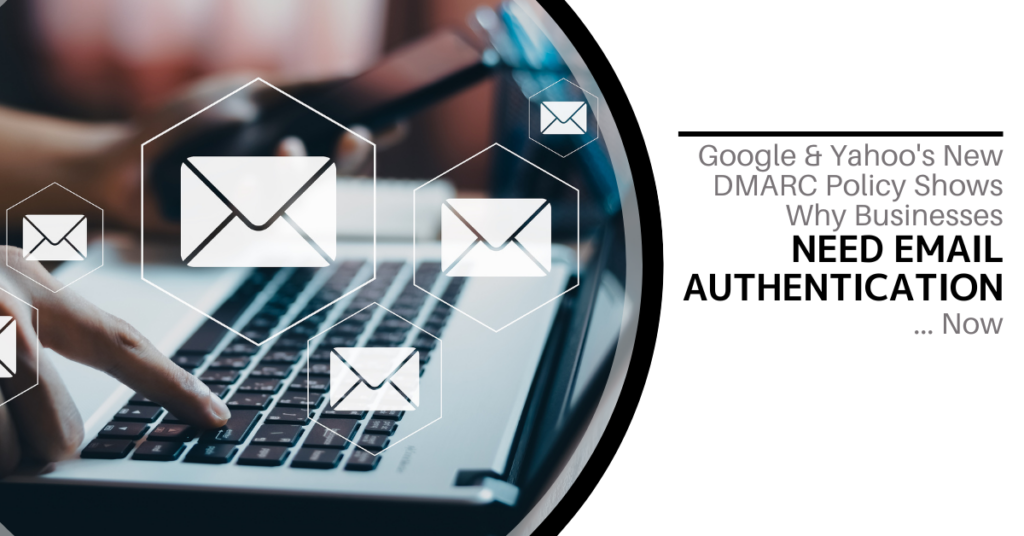|
Getting your Trinity Audio player ready...
|

The importance of DMARC. Have you noticed the increased focus on email authentication recently? There’s a good reason for it. Phishing remains a significant security threat, consistently causing data breaches and security incidents for years.
A major shift in the email landscape is underway to combat phishing scams. Email authentication is becoming a mandatory requirement for email service providers, making it crucial for your online presence and communication to adapt to this change.
Google and Yahoo, two of the world’s largest email providers, implemented a new DMARC policy effective February 2024. This policy makes email authentication essential for businesses sending emails through Gmail and Yahoo Mail.
But what exactly is DMARC, and why is it so important now? Let’s delve into email authentication and why it’s more critical than ever for your business.
The Email Spoofing Problem
Imagine receiving an email that appears to be from your bank, urgently requesting action. You click a link, enter your details, and suddenly, your information is compromised. This is email spoofing, where scammers disguise their email addresses to appear as legitimate entities. They may spoof a business’s email address, emailing customers and vendors pretending to be that business.
These deceptive tactics can have severe consequences for companies, including:
- Financial losses
- Reputational damage
- Data breaches
- Loss of future business
Unfortunately, email spoofing is a growing problem, making email authentication a critical defense measure.
What is Email Authentication?
Email authentication verifies that your email is legitimate, ensuring the server sending the email is authorized and reporting unauthorized uses of a company domain. It involves three key protocols, each with a specific function:
- SPF (Sender Policy Framework): Records the IP addresses authorized to send email for a domain.
- DKIM (DomainKeys Identified Mail): Allows domain owners to digitally sign emails, verifying their legitimacy.
- DMARC (Domain-based Message Authentication, Reporting, and Conformance): Provides instructions to receiving email servers on handling SPF and DKIM check results and alerts domain owners about domain spoofing.
SPF and DKIM are protective measures, while DMARC provides critical security enforcement information, preventing scammers from using your domain name in spoofing attempts.
Here’s how it works:
- Set up a DMARC record in your domain server settings. This record informs email receivers (like Google and Yahoo) about the IP addresses authorized to send emails on your behalf.
- When you send an email, the receiver’s mail server checks if the email is from an authorized sender.
- Based on your DMARC policy, the receiver can take action such as delivering, rejecting, or quarantining the email.
- You receive DMARC authentication reports, informing you whether your business email is being delivered and if scammers are spoofing your domain.
Why Google & Yahoo’s New DMARC Policy Matters
Google and Yahoo have offered some spam filtering but did not strictly enforce DMARC policies. The new DMARC policy significantly enhances email security:
- Starting in February 2024, businesses sending over 5,000 emails daily must implement DMARC.
- Both companies also have policies for those sending fewer emails related to SPF and DKIM authentication.
Expect email authentication requirements to continue evolving, necessitating attention to ensure the smooth delivery of your business emails.
The Benefits of Implementing DMARC
Implementing DMARC isn’t just about complying with new policies; it offers several benefits for your business:
- Protects your brand reputation: DMARC helps prevent email spoofing scams that could damage your brand image and customer trust.
- Improves email deliverability: Proper authentication ensures your legitimate emails reach recipients’ inboxes instead of spam folders.
- Provides valuable insights: DMARC reports offer detailed information, giving visibility into how different receivers handle your emails, helping you identify potential issues and improve your email security posture.
Taking Action: How to Implement DMARC
Implementing DMARC is crucial, especially with the rising concerns about email spoofing. Here’s how to get started:
- Understand your options
- Consult your IT team or IT security provider
- Regularly track and adjust your settings
Need Help with Email Authentication & DMARC Monitoring?
DMARC is just one piece of the email security puzzle. Implementing email authentication is essential, but it’s one of many security measures required in today’s digital environment. If you need help setting up these protocols, we’re here to assist.
Contact us today to schedule a chat.
Twintel has grown into an expansive, full team of IT services professionals, acting as the outsourced IT department of non-profits, small to mid-size businesses, and enterprise-level corporations in Orange County, across California, and nationally.
Today, it’s the strength and deep expertise of the Twintel team that drives positive outcomes for clients. Each of the support staff, technicians, and engineers works diligently each day to make sure that the companies served have the seamless, secure, and stable IT environments needed to allow them to pursue their organizational objectives.